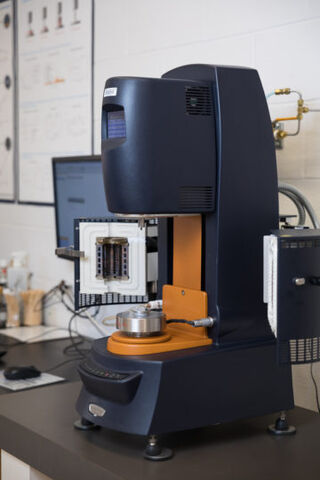TA Instruments DHR3 Rheometer
TA Instruments DHR3 Rheometer
Bard Hall B56 (Primary Staff: Kevin Silverstein; Secondary Staff: Mark Pfeifer)
The DHR3 can be used to measure viscosity, shear stress, storage/loss modulus, strain, and phase angle with respect to time, temperature, shear rate and frequency. It can also be used for transient testing such as creep and stress relaxation, and UV cure kinetics. Available geometries include: 40 mm parallel plate, 25 and 40 mm 2° cones, and cup and rotor with options of vaned or conical rotor. It has three heating system options, Peltier plate, Peltier concentric cylinders, and an environmental test chamber.
Specifications
- Torque, minimum oscillation 0.5 nN·m, minimum steady shear 5 nN·m, maximum 200 mN·m;
- Torque resolution, 0.05 nN·m;
- Frequency, 1.0 E-07 to 100 Hz, Angular velocity, up to 300 rad/s;
- Strain step time, 15 ms;
- Rate step time, 5 ms;
- Maximum normal force, 50 N;
- Normal force sensitivity, 0.005 N;
- Normal force resolution, 0.5 mN;
- Temperature range, -20 °C to 60 °C, or 60 °C to 500 °C – depending on configuration.
Accessories:
The UV curing accessory allows for room temperature characterization of cure kinetics for UV active materials in the 320-500 nm range on the DHR3 Rheometer. It consists of a mercury vapor lamp and a light guide to direct light through a transparent lower plate onto the sample. Optical filters allow specific measurement at 365 nm and band pass at 400-500 nm. Output intensities up to 300 mW/cm² are possible. Geometry options are limited to a 20 mm disposable aluminum upper plate and quartz or acrylic lower plate. This fixture was also purchased in conjunction with a Photo Curing Accessory for use with our Q1000 DSC for acquiring complementary cure kinetics through calorimetry.
The Tribology fixture enables the study of interfacial coefficient of friction between a lubricant and two wear surfaces on the Rheometer. Standard surfaces include steel on steel, polymer on steel, and polymer on polymer. Some custom surfaces can be accommodated but need to be discussed with facility staff ahead of time.



